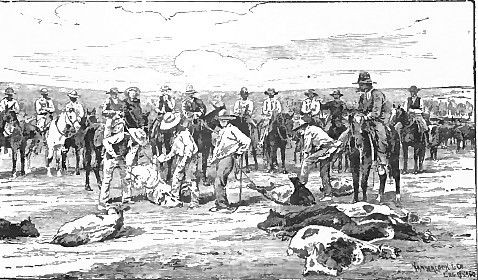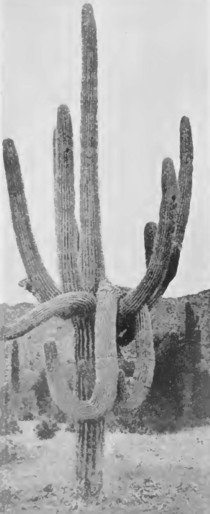While it has been estimated that the dividends from gold ore, silver and lead produced in the early days of Arizona's history amounted to $100,000,000. it was not until the great copper properties of the State had begun to be developed that Arizona really became a world power in the wealth of its minerals, producing in one year, 1916, metals to the value of $203,000,000. The bulk of the great copper production of the State comes from eleven companies, which are in order of dividend amounts paid, The Copper Queen, United Verde, Calumet and Arizona, Arizona Copper, Old Dominion (consolidated companies), Detroit Copper, Superior & Pittsburg, Miami Copper, Shattuck Arizona, Shannon Copper and Ray Consolidated, which have paid dividends of record to 1916, amounting to $225,000,000.
THE COPPER QUEEN
To Jack Dunn, a Government scout, belongs the honor of discovering the
Copper Queen, one of the greatest copper producing mines in the world. In
1877 while on a scouting trip in the Mule Pass Mountains, where the city
of Bisbee now stands, he noticed some
copper ore float that looked promising. Returning from his trip,
Dunn, at Ft. Bowie, met George Warren, a
prospector of the average shiftless, optimistic type, told him about his
find, and grubstaked him on the usual basis that the man who furnished the
provisions should own half the property found. John Cady, an Arizona
pioneer, says that Warren was also grubstaked about this time by George
Stephens at Eureka Springs, in any event, on December 27, 1877, Warren, with
four others (neither Dunn's nor Stephen's names appearing) located the Mercy
claim, which was afterwards called the Copper Queen.
During the next few months a number of other claims were located, in several
of which Warren had an interest, but his finds did him little good; he soon
sold out whatever interest he had in the various properties and squandered
the money. It is said that he lost one claim in a drunken wager over a horse
race. Warren drank himself into poverty almost to dementia and after living
a number of years on a pension from the Copper Queen Company, died at
Bisbee. The modern development of the great Copper Queen mine may be said to
have had its genesis in 1880 with the arrival of Dr. James Douglas who had
just come from the inspection of the United Verde. At that time Edward
Riley, who had taken a bond on the mine, had disposed of it to a San
Francisco firm of engineers, Martin and Ballard, who erected a small furnace
and smelted some
ore.
Upon recommendation of Doctor Douglas, the Phelps-Dodge Company purchased property adjoining the Martin-Ballard-Riley claim at a cost of $40,000. It is said that both mines, seemingly, had about exhausted their paying ore, when a foreman, J. W. Howell, on his own initiative and against orders, started a drift which finally broke into a remarkably rich body of ore. Afterwards the Copper Queen acquired the Holbrook, Neptune and other properties which ultimately became their most profitable holdings. Copper Queen ores average about six per cent copper. The present operating company (1918) employs 3,000 men and handles 2,500 tons of ore daily. Its great smelters, models of their kind, are located at Douglas.
CALUMET AND ARIZONA
The Calumet and Arizona mines, which rank third in the state as dividend
payers, are also in the Warren district. The original owner of the Irish Mag,
which became the nucleus of the properties of the company, was a queer,
misanthropic character named James Daley, who lived in Mule Gulch, in the
outskirts of Bisbee. In resisting arrest, Daley shot an officer and fled
into Mexico. Afterwards a saloon keeper by the name of Andy Mehan produced a
bill of sale of the mine to himself which bill of sale was attached by Cohan
Brothers, merchants living in Tombstone. A second claimant for Daley's mine
was Martin Costello, who acquired the title by buying the claim of a Mexican
woman who said she was Daley's legal widow. A second wife and third claimant
appeared on the scene from Leadville. The outcome of the litigation, which
lasted for ten years, was that Costello got the mine, which he sold to the
"C. & A." for over a half million of dollars. The mine is a deep one. At the
850-foot level small bunches of ore were found, and at the 1,050, a splendid
body of copper-bearing rock was encountered out of which over $10,000,000
was paid in dividends. A small smelter was built near Douglas, which was put in operation in November, 1902. Following a policy of
expansion, development companies were formed, these being known as the
Junction Development Company, the
Pittsburg and Duluth Development Company, the Calumet and Pittsburg
Development Company, and the Lake Superior and Pittsburg Company, and in
1910 all were brought into the Calumet and Arizona Mining Company, giving
the latter organization more than 2,000 acres of mineral land. One of the
latest acquisitions of the Company, as noted elsewhere, is the New Cornelia
property at Ajo.
THE SHATTUCK ARIZONA
The Shattuck Arizona is a neighbor of the Copper Queen and the Calumet and
Arizona, and though its output is given as only about 500 tons daily, it is
ninth on the list of dividend producers. It is often called the "Biggest
Little Mine," for while its surface area is small, it is big in every other
way. Its cost of production for 1912 was given as 7.22 cents on 13,000,000
pounds of copper. It is interesting to note that the Shattuck contains a
larger variety of minerals and produces commercially more different minerals
than any other mine in the State. Some of its ores have high values in
native gold and silver. A drift on the 300-foot level
encountered a cave, wonderful in its beauty, with a stalactite-studded dome
eighty feet high, about which hang coral like deposits in many beautiful
colors.
THE UNITED VERDE
The United Verde, Senator W. A. Clark's great mine at Jerome, is perhaps the
best known copper mine in the State. The earliest location in the Black
Hills section, where the mine is situated, is
supposed to have been made, in 1877, by
General Crook's famous scout, Al. W. Sieber, and called the Verde from the
river, not far away. In 1877 the Verde mining district was organized. Among
the owners of locations in the district a little later were Angus and John
McKinnon, who were working the Wade Hampton. In 1882 they sold their claim
to F. F. Thomas, who believing that a big mine lay within the steep
hillsides, bonded the adjoining Eureka, the Hermit, the Azure and the
Adventure Chromes, and took in George A. Treadwell, the mining expert, as a
partner.
The United Verde Copper Company was organized in 1883 with Thomas as superintendent and general manager. A fifty ton smelter was built. While the smelting of the ores proved the mine to be wonderfully rich, not only in copper but in silver as well, reduction processes were primitive and transportation to the Atlantic and Pacific Railroad at Ash Fork was so expensive that in 1884, when copper was worth about seven cents a pound, the mine was shut down.
Governor F. A. Tritle secured a bond and lease on the property in 1887, but conditions did not improve enough to put the mine on a paying basis. Still, much rich ore was taken out and Governor Tritle was a lavish host to the many visitors who came to Jerome to inspect the mine. At the request of Governor Tritle, Prof. James Douglas, who afterwards was prominent in the development of the Bisbee mines, examined the United Verde properties, but finally reported that he thought the mine too far away from a railroad to be worked profitably. Soon after, Senator Clark visited the camp, bringing with him his mining experts, J. L. Giroux and John L. Thompson. As a result of their investigations Clark purchased the mine, and under scientific development, turned it into one of the greatest paying properties in America. He built a narrow-gauge railroad from the Sante Fe Prescott and Phoenix to the mine in 1894, and in 1915 abandoned the smelter which was located at Jerome, and now reduces all of the Company's ores at Clarkdale on the Verde, where at an expense of $3,000,000 there has been constructed a plant that is one of the most perfect of its kind in the world.
Return
to The Arizona Page:
Arizona Gold Rush Mining History



